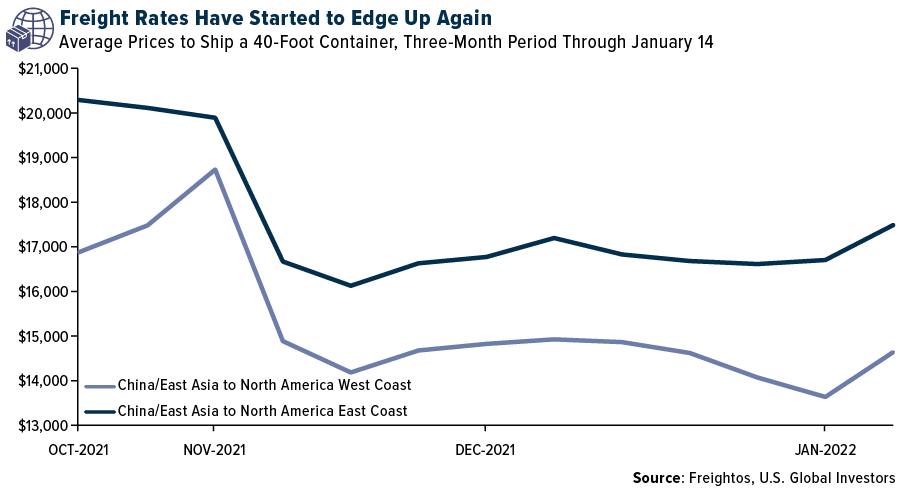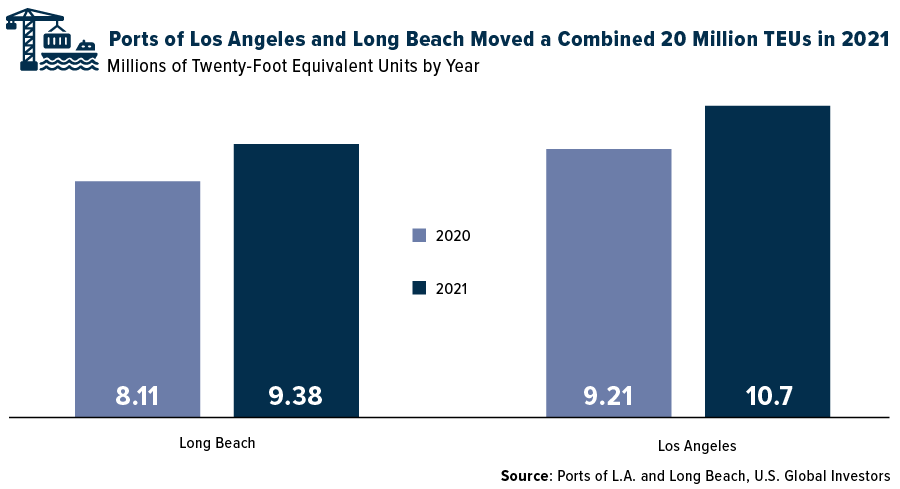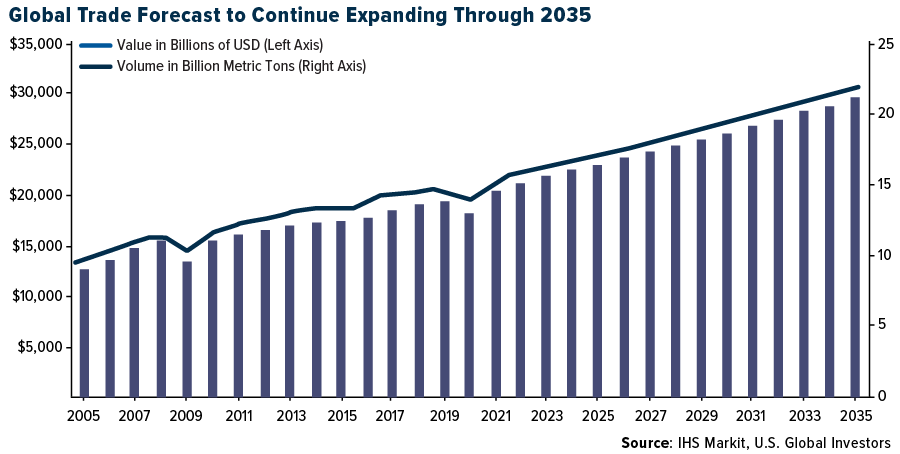
The Shipping Industry Has Never Been So Profitable as It Is Now
A “boatload” of news this week suggests that the shipping industry continues to look very attractive from an investing point of view.
A “boatload” of news this week suggests that the shipping industry continues to look very attractive from an investing point of view. For starters, global cargo carriers are estimated to have recorded $150 billion in profits in 2021, the first time they’ve collectively reached that figure in a single year.

Indeed, net income has never been bigger, and it’s not even close. Denmark’s A.P. Moller-Maersk, known simply as Maersk, is expected to report an annual profit that meets or exceeds the combined profits from the past nine years. The world’s second largest carrier, having recently been dethroned by Geneva-based Mediterranean Shipping Company (MSC), sailed up an impressive 72% in 2021 in Copenhagen trading.
To give you an idea of just how cash-flush shipping companies are right now, employees of Chinese state-owned COSCO Shipping, one of our favorite industry names, were paid a jaw-dropping year-end bonus that was 30 times their monthly salary, according to Caixin Global. Taiwanese company Evergreen Marine reportedly doled out a bonus that was as high as 40 times workers’ monthly pay.
Rates Likely to Remain Elevated
The reason for all of this, of course, is record-high freight rates. Last year, as Covid forced households around the world to shift a lot of their discretionary spending from experiences to goods, the rate to ship a 40-foot container rose to as much as $20,000 in some cases, compared to less than $2,000 in 2019.
Although rates have come off their highs, they’ve lately begun to turn up again as the more transmissible Omicron variant has led to new lockdowns around the world. That includes in China, which CLSA points out has a zero-tolerance approach to controlling the spread of Covid. “Global supply chain pressures are likely to persist, therefore, for much of this year,” CLSA analysts wrote in a note to clients dated January 20.

That thought was echoed by Peter Sand, chief analyst at ocean and air freight benchmarking platform Xeneta. In his weekly update, Sand said he believed that average shipping rates in 2022 “will be higher than ever before,” thanks to companies’ strong pricing power and ability to negotiate long-term rates.
Ports of L.A. and Long Beach Moved a Record Number of Containers
In the past several months, you may have run into some empty store shelves, but it’s not due to a lack of effort. The Ports of Los Angeles and Long Beach released their shipping statistics for calendar year 2021, showing that they’ve never before moved so many containers in a single year. Long Beach handled a record 9.38 million 20-foot equiavlent units (TEUs), a 16% jump in volume from 2020 numbers, while Los Angeles reported moving 10.7 million TEUs, also an increase of 16% from the previous year. Collectively, the two ports, which represent over 25% of North America’s total inbound container trade, handled an unheard-of 20 million TEUs.

It’s not just sea freight, though. Air freight companies had a phenomenal 2021. FedEx, another name we really like, reported record profit and record revenue of $84 billion last year, largely due to greater volumes. FedEx Express, one of the world’s largest cargo airlines, handled an average of 3.28 million packages per day domestically in 2021, up from 2.90 million packages per day in 2019.
Can Trade Continue to Grow at this Level?
In many ways, last year was an anomaly, and we can’t expect growth in trade volumes to continue at the same high rate indefinitely. But by all accounts, we can reasonably expect them to grow year-over-year as more and more people join the middle class and seek to buy the things associated with such a lifestyle.
According to long-term forecasts by IHS Markit, the real value of traded goods could approach $30 trillion by 2035, up from just over $20 trillion today. Barring another global event like a war, pandemic or economic downturn, volume could exceed 20 billion metric tons, compared to 15.8 billion metric tons today, IHS Markit says.

To be transported all over the world, these future goods will need ships and cargo jets, not to mention ports, a few operators of which are publicly traded. As Americans, we don’t think of airports and seaports as being investable companies, but a few of them are in other countries, including the Philippines’ International Container Terminal Services, New Zealand’s Napier Ports Holding and the U.K.’s PD Ports and Global Ports Holding.
Be sure to read our most recent press release by clicking here!
Index Summary
- The major market indices finished down this week. The Dow Jones Industrial Average lost 4.58%. The S&P 500 Stock Index fell 5.68%, while the Nasdaq Composite fell 7.55%. The Russell 2000 small capitalization index lost 7.90% this week.
- The Hang Seng Composite rose 2.14% this week; while Taiwan was down 1.75% and the KOSPI fell 4.81%.
- The 10-year Treasury bond yield fell 2 basis points to 1.759%.
Airline Sector
Strengths
- The best performing airline stock for the week was AirTrip, up 17.3%. Allegiant posted its fourth quarter update. Revenue is tracking ahead of consensus, which implies a fourth-quarter earnings per share (EPS) ahead of the consensus of $1.09.

- System net sales improved modestly to -64.4% versus 2019 (and versus last week at -65.5%). The softness in data from the first two weeks of the year is not surprising given the mass cancellations and omicron demand impacts. In the most recent data, both domestic and international bookings improved to -35.5% versus 2019 (and versus -44.2% last week) and -49.1% versus 2019 (and versus -54.7% last week), respectively.
- United Airlines’ fourth-quarter results were somewhat better than consensus. Revenue came in at the better end of the original guide despite omicron-related weakness in international markets in December, partly due to stronger-than-expected cargo trends. United also cited that booking trends for spring/summer travel remain strong.
Weaknesses
- The worst performing airline stock for the week was AeroMexico, down 21.5%. Intra-Europe net sales declined by three points to -71% versus 2019 (and versus -36% last week). International net sales were down by 19 points to -73% versus 2019 (and versus -54% last week). This led to a 23-point decline in system-wide net sales for flights booked in Europe to -73% versus 2019 (and versus -50% last week).
- Pricing declined with system pricing falling to -40.3% versus 2019 (versus -33.7% last week), as airlines are dropping prices in the near term to spur bookings given omicron impacts. In addition, this is one of the historically weaker bookings periods.
- Global flight schedules for January and February were broadly reduced again this week with January capacity down 1% (still at 68% of 2019 levels) and February down 2% (now 71%) while March was also reduced by 1% (now 78%) but was driven by Asian and North American cuts. Most regions cut January ASMs by 1% while Asia, Europe and Africa cut February by 2%.
Opportunities
- Regional airlines will be the biggest beneficiaries amidst already tight pilot supply and should now avoid the potential for costly ongoing testing. The recent Supreme Court ruling is not applicable to mainline airlines that are contractors with the federal government. Staffing issues should also benefit from the late-December CDC recommendation that lowered isolation periods from 10 to 5 days for those who test positive for the virus.
- Turkish Airlines’ shares have shown resilient performance against macro volatility and have outperformed its global peers with a 58% return since the beginning of December. The company operated at 87% capacity of 2019 levels in December. The recovery remained firm, led by long-haul routes particularly North America and LATAM, while positive momentum has started to be more visible in Asian routes. Yields have been strong and reached pre-COVID levels, particularly in international markets, which should help the company continue to surprise positively on its financial performance.
- According to Goldman, its proprietary pricing study data shows that fares are improving into President’s Day weekend as compared with recent fares over the Martin Luther King Jr. holiday weekend, corroborating recent airline commentary that a material improvement in demand is expected from President’s Day forward.
Threats
- A major near-term risk for airlines is the 5G rollout by telecommunications companies. Per media reports, 45% of the U.S. commercial fleet has been approved by the FAA to perform low-visibility landings where 5G will be deployed, which implies potential widespread disruptions to commercial aviation. According to the FAA, “safety experts determined that 5G interference with the aircraft’s radio altimeter could prevent engine and braking systems from transitioning to landing mode, which could prevent an aircraft from stopping on the runway.”
- Bank of America’s base case is that China maintains its zero COVID policy through 2022. The bank cut its 2022 forecasts on all the Chinese major airlines, and now assumes 85% of normal domestic traffic due to periodic lockdowns and 10% of normal international traffic in 2022 as Chinese borders stay closed. Recently, China has suspended routes with little to no warning, with 70 flights from U.S. airlines suspended in 2022.
- American Airlines introduced a fiscal year 2022 outlook, guiding capacity to be down 5% versus 2019 which compares to prior commentary that capacity would be near 2019 levels. Management expects CASM ex-fuel to be up 5% versus 2019. American noted a negative impact to January/February demand from Omicron and is guiding March quarterly revenue to be down 20% to 22% versus 2019, with consensus being down 15%.
Emerging Markets
Strengths
- The best relative performing country in emerging Europe for the week was Hungary, losing 1.4%. The best performing country in Asia this week was Hong Kong, gaining 1.91%.
- The Turkish lira was the best performing currency in emerging Europe this week, gaining 0.64%. The Thailand baht was the best performing currency in Asia this week, gaining 0.70%.
- China’s real GDP picked up in the fourth quarter, slowing less than expected. The economy grew 1.6% versus expected growth of only 1.2%. On a year-over-year basis, China’s economy expanded 4.0% versus 3.3% consensus, but below the previously reported GDP of 4.9%.
Weaknesses
- The worst performing country in emerging Europe for the week was Romania, losing 6.4%. The worst performing country in Asia this week was India, losing 3.8%.
- The Hungarian forint was the worst performing currency in emerging Europe this week, losing 1.1%. The Taiwanese dollar was the worst performing currency in Asia this week, losing 0.35%.
- Prices are raising in Chin, which seems to be in line with the global trend. December inflation for the mainland was reported at 1.5% and Hong Kong recorded an increase of 2.4%, above the November reading.

Opportunities
- China is committed to support its slowing economy due to the spread of COVID cases and the country’s zero tolerance policy. On Monday, the PBOC cut its medium-term lending facility rate by 10 basis points to 2.85%. This was the first policy rate cut since April 2020. Later in the week, the one-year prime loan rate was cut by 10 basis points and the five-year loan rate was cut by 5 basis points.
- Macau casino stocks jumped by the most in six years on Monday after the release of the revised gaming bill. No more than six licenses will be awarded, paving the way for current operators to renew permits that are set to expire in June. Morgan Stanley sees the Macau gaming industry as attractive now and expects gradual border opening between Hong Kong and mainland China and Macau as a main driver of stronger revenue/EBITDA closer to 2019 by 2023.
- Wood & Company, a broker with a primary focus on central emerging Europe, will not attempt to predict how much lower the Russian stock market could fall in case the country decides to attack Ukraine. However, the group has observed many times before periods of rising tension, followed by de-escalation and a strong market rebound. Russian equites in dollar terms are down 9% year-to-date and 23% since the start of October 2021.
Threats
- According to Bloomberg research, China’s property developers’ offshore bonds have lost $82 billion in value. Market capitalization of offshore property bonds has fallen from $151 billion of par value to $69 billion. Further analysis shows that developers face a growing risk of liquidity crunch and more defaults to follow. On Monday, developers trading in Hong Kong sold off on news that Country Garden failed to gain investor support for a convertible bond deal.
- China will impose new curbs on technology giants. China’s internet overseer will require companies to seek approval before making investments or raising funds. The Cyberspace Administration of China is drafting new guidelines that will require any company with more than 100 million users or over 10 billion yuan ($1.6 billion) in revenue to seek the watchdog’s approval before such deals.
- Reverse gas supplies via the Yamal-Europe gas pipeline from Germany to Poland have continued for a month, according to information provided by the gas transport operator Gascade. Gazprom gas exports to non-Commonwealth of Independent States (CIS) countries fell by 41.1% in the first half of January 2022 to 5.4 billion cubic meters. Geopolitical tension between Russia and the Eurozone will escalate if Russia continues to use energy as a bargaining weapon.
Energy & Natural Resources
Strengths
- The best performing commodity for the week was tin, up 8.54%, as the metal approaches all-time highs amid strong demand from the electronics sector while supply lines are tight but stockpiles are also falling. According to Bank of America, towards the end of last year the single issue dominating the energy sector outlook was the pace of crude additions from OPEC+ and increasing focus on capacity constraints across member countries. But since the start of the year, the rebound has taken spot oil prices to the highest level since 2014 and lifted the back end of the curve over $65. The bank’s thesis for the U.S. and Canadian oils is simple: What does the sector look like at Bank of America’s current base case ($60 Brent) and more importantly, at $70 long dated Brent? The simple answer is upside of 40%-90%.
- Exxon Mobil announced its first long-term pledge to curb carbon emissions starting with Scope 1 and 2 emissions however the plan excludes carbon output from automotive or jet engines. While Exxon’s plans are not as ambitious as European peers, at least it’s a start.
- Global benchmark Brent crude has jumped 25% to around $88 a barrel since the end of November. Some in the market now think it’s a question of when — not if — oil hits triple digits, somewhere it has not been since 2014. Goldman Sachs said this week it sees prices reaching $100 in the third quarter as consumption surprises to the upside.
Weaknesses
- The worst performing commodity for the week was lumber, down 12.61%. Fluctuations in the prices of building supplies are complicating the construction of new homes, according to MarketWatch. Lumber prices typically only vary by 0.3% from month to month for the period of 1947 to 2019. Since January 2020, the monthly volatility has averaged closer to 12%.

- DSM, DuPont and Lanxess all announced a strategic review, and intention to sell, their respective nylon businesses. There is also a structural threat on the horizon in the form of electric vehicles which may reduce the polyamide content in a vehicle by a considerable amount: 46% by volume according to a Volvo sponsored study. Autos is the key end market for nylon, being 25-50% of sales.
- Global food prices are hovering at record levels as fertilizer shortages, harvest disruptions and labor shortages all work to boost the prices of food items. In addition, higher energy prices mean some food items get diverted to making biofuels. Food inflation can lead to political instability for some nations.
Opportunities
- Goldman forecasts long-dated oil prices rising to $90 per barrel, with a Brent spot forecast of $105 in 2023 (and 2022 at $96). There will be ever rising oil prices given the reluctance to invest in oil during the energy transition. The investment bank believes there are sharp revisions ahead to consensus/forward/spot oil price estimates. Goldman continues to see the Energy sector as well positioned to partially reclaim its lost market share in the S&P, with the XLE having moved from 10% of the broader index in 2010 to 3% currently.
- The green-energy transition is poised to triple India’s consumption of aluminum by the end of the decade, according to an industry group. The South Asian nation, which is home to some of the most polluted cities on the planet, has pledged to zero out emissions by 2070. Decarbonization will drive demand for aluminum-intensive solar power infrastructure, and higher use of the metal in other industries, pushing up consumption to ten million tons a year by 2030, according to the Aluminum Association of India.
- Iron ore led gains among industrial metals as China vows to use more monetary policy tools to spur the economy, brightening the outlook for raw materials demand. Futures in Singapore climbed to more than $130 a ton, while base metals including nickel continued their new year rally. The central bank this week cut its policy interest rate for the first time in almost two years, signaling the beginning of an easing cycle.
Threats
- Nickel’s biggest supply squeeze in more than a decade is drawing attention from the London Metal Exchange (LME), as plunging inventories mean buyers are forced to pay massive premiums for immediately available metal. Cash contracts on the LME reached a $90-a-ton premium to those expiring a day later, the highest since 2010 and nearing levels seen in 2007 during a historic squeeze. The bourse has stepped up its monitoring of the nickel market in response and may take further measures to ensure orderly trading if needed, a spokesperson said by email.
- RBC believes China’s collapse in steel consumption in the second half of last year could be a harbinger of things to come. Although sentiment has picked up, and iron ore is off its lows, the medium-term outlook remains challenged. The iron ore market is in a structural surplus. RBC’s detailed supply/demand modelling shows a growing surplus that brings prices back through recent lows. The bank expects prices to fall to $75 per ton through the year, averaging $100.
- China, maker of more than half of the world’s aluminum, is ramping up overseas shipments yet again. Exports of unwrought aluminum and products were back at an all-time high in December after a power crisis forced European smelters to cut output. This could negatively impact prices.
Domestic Economy & Equities
Strengths
- December housing starts posted a surprise increase of 1.4% to a 1,702,000 million SAAR, beating estimates of 1,650,000 million. The strong December data pushed the 2201 total above 2020’s levels by 15.6%.
- January’s Philadelphia Fed Manufacturing Index came in at 23.2, better than consensus for 20.0 and December’s 15.4 level.
- Activision Blizzard, a gaming company, was the best performing S&P 500 stock for the week, increasing 24.42%. Shares gained more than 25% on Tuesday after Microsoft offered to buy the company for $68.7 billion.
Weaknesses
- January’s Empire State Index fell 32.6 points month-over-month to -0.7, which was a big miss from the consensus of 25.0 and the lowest print since May 2020. New orders dropped 32 points to -5.0, while the delivery times index was reported steady at 21.6, suggesting delays continued to lengthen.
- Initial jobless claims came in at 286,000 for the latest week, well ahead of consensus for 220,000 and ahead of last week’s upwardly revised 231,000. Jobless claims are at the highest level since October of last year. Continuing claims were reported higher as well at 1,635,000 and above the prior reading of 1,559,000.
- Netflix, a video streaming platform, was the worst performing S&P 500 stock for the week, losing 25.63%. Shares declined on Friday by 22% after the company warned of fewer new subscribers.
Opportunities
- The latest Bank of America Global Fund Manager Survey shows that investors are still bullish on equities, with the biggest overweight in stocks versus bonds since February 2011, FactSet reported. However, investors did make big rotations from growth to value names, given rate expectations, with 44% saying hawkish central bank rate hikes is the biggest tail risk.
- President Biden said Wednesday that it was too soon to make commitments on easing U.S tariffs on Chinese goods, however some business groups have been pushing for him to start unwinding the tariffs. JPMorgan noted that a reversal of existing tariffs could represent a direct earnings per share benefit of $5 for the S&P 500. This would help inflation to reverse its course.
- Preliminary PMIs for January will be released next week. PMIs are expected to remain well above the 50 level. Bloomberg economists predict the Manufacturing PMI to be released at 57, slightly lower than the December reading of 57.7.
Threats
- Yields continue to move higher. The 10-year U.S. Treasury yield hit 1.9% on Wednesday, its highest point since December 2019, but later retreating.
- The biggest market concern continues to be higher and quicker unexpected rate hikes by the Federal Reserve. Most investors expect a 25 basis points hike in March, but some speculate a 25-basis points adjustment to the rate. The Fed hasn’t tightened that much in one shot since May 2000, when its tightening cycle was already well underway.
- Conference Board Consumer Confidence is expected to drop to 112.0 in January from 115.8 in December. A lower reading means that consumers are becoming more pessimistic regarding their expected financial situation.
Blockchain and Digital Currencies
Strengths
- Of the cryptocurrencies tracked by CoinMarketCap, the best performer for the week was Project X Nodes (PXT), rising 1,739%.
- According to Bloomberg, Soros Fund Management and the Winklevoss twins’ venture capital firm are among investors in a funding round that’s more than doubled the valuation of Animoca Brands Corp, a non-fungible token and metaverse company to $5 billion. Animoca and its subsidiaries offer NFTs, and games tied to blockchain platforms, the article continues, both its own creations and collaborations with outside brands, spanning mobile devices, home consoles and web.
- Even after Bitcoin’s recent 40% slide, MicroStrategy’s Michael Saylor says he’ll never back down on pushing his company’s multi-billion bet on the world’s largest cryptocurrency, writes Bloomberg.
Weaknesses
- Of the cryptocurrencies tracked by CoinMarketCap, the worst performing for the week was Vagabond (VGO), down 99.75%.
- The CEO of Bitcoin cash back app Mode Global has resigned two months after being forced to “clarify” that the company was not working with some of the U.K.’s top retailers, writes Bloomberg. CEO Ryan Moore left on Wednesday after being in charge for just nine months.
- One of the biggest casualties of the cryptocurrency selloff is the Grayscale Bitcoin Trust, according to Bloomberg. The $27 billion fund has plunged nearly 17% so far in 2022, outpacing Bitcoin’s nearly 9% decline. As a result, GBTC’s price closed 26.5% below the value of the Bitcoin it holds on Tuesday.
Opportunities
- New York City’s new mayor, Eric Adams, said his first paycheck will be converted into Bitcoin and Ethereum. According to Bloomberg, the paycheck, expected Friday, will be converted into cryptocurrency through the online platform Coinbase Global Inc.
- Latin American e-commerce powerhouse MercadoLibre Inc. is deepening its presence in the crypto world, writes Bloomberg. The company made two significant purchases: 1) It acquired shares of 2TM Participacoes SA (the Softbank Group-backed owner of the biggest crypto brokerage based out of Brazil, MercadoBitcoin.com), and 2) It made a strategic investment in New York-based Paxos, a blockchain company.
- Ex-Goldman Sachs Group bond trader Dan Morehead is building a crypto behemoth, writes Bloomberg. He was among the few who bought crypto early, launching his first crypto fund when Bitcoin cost less than a bag of groceries. As a result, the Pantera Bitcoin Fund has returned over 65,000% since 2013, the article continues.

Threats
- Crypto exchanges are set to be a primary focus of the U.S. SEC’s crackdown on digital assets in 2022, according to Bloomberg. SEC Chairman Gary Gensler said on Wednesday that he’s hopeful that trading platforms will take steps in coming months to be more directly regulated by Washington’s financial regulators.
- Russia’s central bank on Thursday proposed a complete ban on crypto mining and trading, according to Bloomberg. Russia, which houses roughly 10% of global Bitcoin mining activities, said digital assets bear the hallmarks of a pyramid scheme and could pose a threat to the country’s financial system.
- Bitcoin tumbled in an extended selloff for cryptocurrencies, falling past $38,000 to its lowest level in six months. Ethereum fell below $3,000 losing as much as 11% as investors offloaded risky bets in a volatile week, writes Bloomberg.
Gold Market
This week spot gold closed at $1,817.38, up $17.44 per ounce, or 0.96%. Gold stocks, as measured by the NYSE Arca Gold Miners Index, ended the week higher by 2.39%. The S&P/TSX Venture Index came in off 5.14%. The U.S. Trade-Weighted Dollar rose 0.51%.
| Date | Event | Survey | Actual | Prior |
|---|---|---|---|---|
| Jan-16 | China Retail Sales YoY | 3.8% | 1.7% | 3.9% |
| Jan-18 | Germany ZEW Survey Expectations | 32.0 | 51.7 | 29.9 |
| Jan-18 | Germany ZEW Survey Current Situation | -9.0 | -10.2 | -7.4 |
| Jan-19 | Germany CPI YoY | 5.3% | 5.3% | 5.3% |
| Jan-19 | Housing Starts | 1,650k | 1,702k | 1,678 |
| Jan-20 | Eurozone CPI YoY | 5.3% | 5.3% | 5.3% |
| Jan-20 | Initial Jobless Claims | 225k | 286k | 231k |
| Jan-25 | Conf. Board Consumer Confidence | 112.0 | — | 115.8 |
| Jan-26 | New Home Sales | 765k | — | 744k |
| Jan-26 | FOMC Rate Decision (Upper Bound) | 0.25% | — | 0.25% |
| Jan-27 | Hong Kong Exports YoY | — | — | 25.0% |
| Jan-27 | Initial Jobless Claims | 260k | — | 286k |
| Jan-27 | Durable Goods Orders | -0.5% | — | 2.6% |
| Jan-27 | GDP Annualized QoQ | 5.3% | — | 2.3% |
Strengths
- The best performing precious metal for the week was palladium, up 12.21%. Suki Cooper of Standard Bank noted investors were factoring in a recovery in auto demand, but emission standards are likely to get tougher. Last year, palladium fell 22%. Kirkland Lake’s fourth-quarter production came in at 380,000 ounces, 8% higher than consensus. As a result, full-year production of 1.43 million ounces exceeds original guidance of 1.30-1.40 million ounces.
- Eldorado Gold reported 2022 guidance and a refreshed five-year outlook that is slightly ahead of consensus estimates and improves upon its prior outlook. The company’s 2022 production guidance of 460-490,000 ounces is 2% higher than consensus. Five-year guidance overall is 4% higher than Eldorado’s prior forecasts.
- Gold advanced to a two-month high as investors sought the metal for an inflation hedge amid falling yields across the U.S. Treasury curve, writes Bloomberg. U.S. stocks slipped in choppy trading as investors assessed outlooks for earnings growth amid the potential for monetary policy tightening. Falling bond yields and a weaker greenback helped boost bullion’s appeal, the article continues. Gold has mostly held above $1,800 an ounce in January, after dropping in 2021 for the first time in three years as central banks globally started dialing back on pandemic-era stimulus.

Weaknesses
- The worst performing precious metal for the week was gold, but still up 0.96%. Alamos Gold’s fourth-quarter production of 113,000 ounces was 9% below consensus but achieved the low end of revised annual guidance. 2022 guidance is weaker than expected, with production of 440–480,000 ounces and 6% below consensus.
- B2Gold also reported fourth-quarter production of 289,000 ounces, 1% below consensus. 2022 guidance of 950-1,000,000 ounces is 2% below consensus, while cash cost guidance of $1,000-$1,040 per ounce is 19% above consensus.
- A truck carrying mining explosives collided with a motorcycle in western Ghana on Thursday, reports Reuters, causing a “huge” explosion, the police said in a statement. The vehicle was heading to the Chirano Mine operated by Kinross Gold. Casualties are at least 17 dead with another 59 injured.
Opportunities
- According to Stifel, Wheaton Precious Metals has announced that it will be acquiring gold and silver streams on Adventus Mining’s high-grade copper-gold Curipamba project for an upfront payment of $175.5 million. Wheaton is visibly in growth mode as this deal comes after the recent precious metal’s streams on the Marathon and Blackwater projects solidify growth beyond the five-year outlook. The Curipamba gold-silver streams provide the company with 50% of payable gold and 75% of payable silver production from the project.
- Vox Royalty Corp. announced that it has executed a binding agreement with a private South African registered company, to acquire two platinum group metals royalties for total consideration of up to C$10,400,000. The royalties include a 1.0% gross receipts royalty for the Dwaalkop Project and a 0.7% gross receipts royalty for the Messina Project.
- Fortuna Silver Mines announced that in 2021, the company produced 207,192 ounces of gold and 7,498,701 ounces of silver. Fortuna said that gold production was 274% higher compared to 2020, whereas silver production was 5% higher over 2020.
Threats
- Pan American Silver reported fourth-quarter production results that were sequentially higher, but below consensus. The company also disclosed that it would not provide 2022 production and cost guidance in January due to uncertainty over COVID-related reduced workforce levels.
- The long-awaited rally in Treasury yields is shaking markets and, yet, gold stands aloof, with bullion over $1,800 per ounce. Gold pays no interest. Rising yields and less negative real rates are bad for gold. But thus far, at least, the yellow metal is standing its ground.
- South Africa’s Association of Mineworkers and Construction Union said it will consult members on a possible strike at Sibanye Stillwater’s gold mines after being granted the legal go-ahead to embark on the action. They will also hold discussions with other unions that have been part of negotiations for a new wage deal at Sibanye’s three gold mines, Secretary-General Jimmy Gama said.
U.S. Global Investors, Inc. is an investment adviser registered with the Securities and Exchange Commission (“SEC”). This does not mean that we are sponsored, recommended, or approved by the SEC, or that our abilities or qualifications in any respect have been passed upon by the SEC or any officer of the SEC.
This commentary should not be considered a solicitation or offering of any investment product. Certain materials in this commentary may contain dated information. The information provided was current at the time of publication. Some links above may be directed to third-party websites. U.S. Global Investors does not endorse all information supplied by these websites and is not responsible for their content. All opinions expressed and data provided are subject to change without notice. Some of these opinions may not be appropriate to every investor.
Holdings may change daily. Holdings are reported as of the most recent quarter-end. The following securities mentioned in the article were held by one or more accounts managed by U.S. Global Investors as of (12/31/2021):
Allegiant
United Airlines
American Airlines
Gazprom Neft
AP Moller-Maersk A/S
COSCO Shilling Holdings Co. Ltd.
Eldorado Gold Corp.
B2Gold Corp.
Wheaton Precious Metals Corp.
Adventus Mining Corp.
Vox Royalty Corp.
Fortuna Silver Mines Inc.
Pan American Silver Corp.
Sibanye Stillwater Ltd.
*The above-mentioned indices are not total returns. These returns reflect simple appreciation only and do not reflect dividend reinvestment.
The Dow Jones Industrial Average is a price-weighted average of 30 blue chip stocks that are generally leaders in their industry. The S&P 500 Stock Index is a widely recognized capitalization-weighted index of 500 common stock prices in U.S. companies. The Nasdaq Composite Index is a capitalization-weighted index of all Nasdaq National Market and SmallCap stocks. The Russell 2000 Index® is a U.S. equity index measuring the performance of the 2,000 smallest companies in the Russell 3000®, a widely recognized small-cap index.
The Hang Seng Composite Index is a market capitalization-weighted index that comprises the top 200 companies listed on Stock Exchange of Hong Kong, based on average market cap for the 12 months. The Taiwan Stock Exchange Index is a capitalization-weighted index of all listed common shares traded on the Taiwan Stock Exchange. The Korea Stock Price Index is a capitalization-weighted index of all common shares and preferred shares on the Korean Stock Exchanges.
The Philadelphia Stock Exchange Gold and Silver Index (XAU) is a capitalization-weighted index that includes the leading companies involved in the mining of gold and silver. The U.S. Trade Weighted Dollar Index provides a general indication of the international value of the U.S. dollar. The S&P/TSX Canadian Gold Capped Sector Index is a modified capitalization-weighted index, whose equity weights are capped 25 percent and index constituents are derived from a subset stock pool of S&P/TSX Composite Index stocks. The NYSE Arca Gold Miners Index is a modified market capitalization weighted index comprised of publicly traded companies involved primarily in the mining for gold and silver. The S&P/TSX Venture Composite Index is a broad market indicator for the Canadian venture capital market. The index is market capitalization weighted and, at its inception, included 531 companies. A quarterly revision process is used to remove companies that comprise less than 0.05% of the weight of the index, and add companies whose weight, when included, will be greater than 0.05% of the index.
The S&P 500 Energy Index is a capitalization-weighted index that tracks the companies in the energy sector as a subset of the S&P 500. The S&P 500 Materials Index is a capitalization-weighted index that tracks the companies in the material sector as a subset of the S&P 500. The S&P 500 Financials Index is a capitalization-weighted index. The index was developed with a base level of 10 for the 1941-43 base period. The S&P 500 Industrials Index is a Materials Index is a capitalization-weighted index that tracks the companies in the industrial sector as a subset of the S&P 500. The S&P 500 Consumer Discretionary Index is a capitalization-weighted index that tracks the companies in the consumer discretionary sector as a subset of the S&P 500. The S&P 500 Information Technology Index is a capitalization-weighted index that tracks the companies in the information technology sector as a subset of the S&P 500. The S&P 500 Consumer Staples Index is a Materials Index is a capitalization-weighted index that tracks the companies in the consumer staples sector as a subset of the S&P 500. The S&P 500 Utilities Index is a capitalization-weighted index that tracks the companies in the utilities sector as a subset of the S&P 500. The S&P 500 Healthcare Index is a capitalization-weighted index that tracks the companies in the healthcare sector as a subset of the S&P 500. The S&P 500 Telecom Index is a Materials Index is a capitalization-weighted index that tracks the companies in the telecom sector as a subset of the S&P 500.
The Consumer Price Index (CPI) is one of the most widely recognized price measures for tracking the price of a market basket of goods and services purchased by individuals. The weights of components are based on consumer spending patterns. The Purchasing Manager’s Index is an indicator of the economic health of the manufacturing sector. The PMI index is based on five major indicators: new orders, inventory levels, production, supplier deliveries and the employment environment. Gross domestic product (GDP) is the monetary value of all the finished goods and services produced within a country’s borders in a specific time period, though GDP is usually calculated on an annual basis. It includes all private and public consumption, government outlays, investments and exports less imports that occur within a defined territory.
The Consumer Price Index (CPI) is one of the most widely recognized price measures for tracking the price of a market basket of goods and services purchased by individuals. The weights of components are based on consumer spending patterns. The Purchasing Manager’s Index is an indicator of the economic health of the manufacturing sector. The PMI index is based on five major indicators: new orders, inventory levels, production, supplier deliveries and the employment environment. Gross domestic product (GDP) is the monetary value of all the finished goods and services produced within a country’s borders in a specific time period, though GDP is usually calculated on an annual basis. It includes all private and public consumption, government outlays, investments and exports less imports that occur within a defined territory.
The Philadelphia Federal Index is a regional federal-reserve-bank index measuring changes in business growth. The index is constructed from a survey of participants who voluntarily answer questions regarding the direction of change in their overall business activities. The survey is a measure of regional manufacturing growth. When the index is above 0 it indicates factory-sector growth, and when below 0 indicates contraction. Also known as the “Business Outlook Survey”.
The Consumer Confidence Index (CCI) is an indicator which measures consumer confidence in the Economy.

































